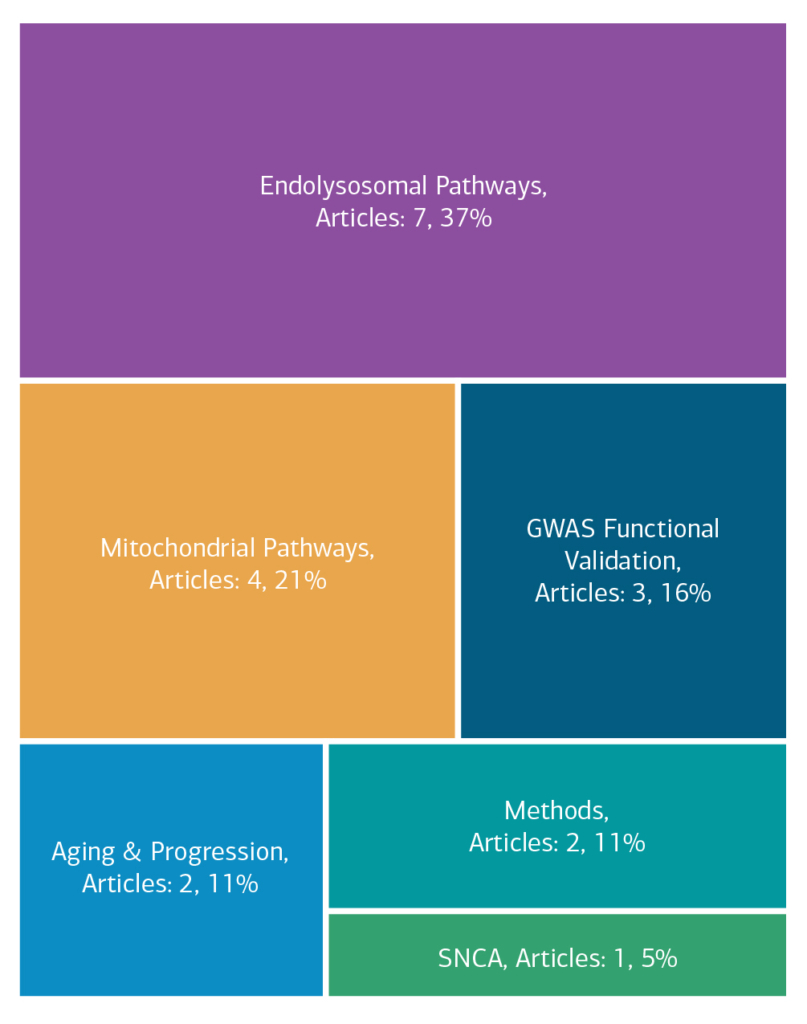PD Functional Genomics | 2020
IMPACT-PD – Implications of Polyamine and Glucosylceramide Transport in Parkinson’s Disease
Study Rationale: Mutations in the genes ATP13A2 (PARK9) and ATP10B trigger Parkinson’s disease (PD) and cause dysfunction of lysosomes, the recycling compartments of the cell. Team Vangheluwe explained these defects by impaired transport of polyamines and glucosylceramide out of the lysosome, respectively. Polyamines are cell protective agents, whereas the levels of the lipid glucosylceramide are controlled by GBA1, the major genetic risk factor of PD. However, there is a clear knowledge gap regarding the biology of polyamine and glucosylceramide transport systems in neurons and their supporting cells of the brain, and how an impaired polyamine and glucosylceramide distribution in these cells leads to neurodegeneration.
Hypothesis: Team Vangheluwe hypothesizes that an impaired polyamine and glucosylceramide transport activity causes toxic accumulation of these substances in lysosomes and leads to a shortage elsewhere in the cell. Together, this may cause lysosomal and mitochondrial dysfunction, and lead to α-synuclein toxicity, three major hallmarks of PD.
Study Design: First, Team Vangheluwe will investigate the molecular architecture of polyamine and glucosylceramide transporters and identify mechanisms to modulate their activity. Second, the team will examine how these transporters influence the intracellular distribution of polyamine and glucosylceramide, and how this affects the cross-talk between lysosomes and mitochondria. Third, they will investigate how dysfunctional polyamine and glucosylceramide transporters affect other PD pathways, such as mitophagy, GBA1 and alpha-synuclein aggregation, and whether the modulation of these transporters can be validated as therapeutic approach for PD. Finally, Team Vangheluwe will collect evidence for disturbed polyamine and glucosylceramide transport in PD patients.
Impact on Diagnosis/Treatment of Parkinson’s Disease: Team Vangheluwe will validate the neuroprotective effect of polyamine and glucosylceramide transporters and investigate their potential to reverse α-synuclein and GBA1 pathology. This may offer new therapeutic strategies that correct aberrant lysosomal and mitochondrial dysfunction in Parkinson’s disease. The team will analyze whether alterations in the polyamine and glucosylceramide levels together may be considered as biomarkers for PD.
Leadership
Project Outcomes
By dissecting the neuroprotective effect of lysosomal polyamine and glucosylceramide transporters at the molecular level, Team Vangheluwe will establish new pathways implicated in Parkinson’s disease that may serve as novel therapeutic targets to restore lysosomal dysfunction in Parkinson’s disease. View Team Outcomes.
Team Outputs
Click the following icons to learn more about the team’s outputs:
Overall Contributions
Here is an overview of how this team’s article findings have contributed to the PD field as of February 2025. There are two different categorizations of these contributions – one by impact to the PD community and a second by scientific category.
Impact

Category

Featured Output
Below is an example of a research output from the team that contributes to the ASAP mission of accelerating discoveries for PD.
Genetically Encoded and Modular SubCellular Organelle Probes (GEM-SCOPe) reveal lysosomal and mitochondrial dysfunction driven by PRKN knockout
Team Vangheluwe developed GEM-SCOPe (Genetically Encoded and Modular SubCellular Organelle Probes), a panel of fluorescent markers that can be used to visualize the localization, distribution, turnover, and oxidative stress of specific organelles.
Team Accolades
Members of the team have been recognized for their contributions.
- Open Science Champions: Marine Houdou
- Awards
- COSA Prize Winners 2021: Stephanie Vrijsen (Community Prize Winner)
- COSA Prize Winners 2022: Eduard Bentea (Second Place)
- 2023 Collaborative Meeting: Eduard Bentea (Third Place Winner in Functional Genomics; San Diego)

Other Team Activities
- Working Groups: iPSC – Joel Blanchard (Co-Chair)
- Protocol Particulars Interview: Assessing Cellular Uptake of Fluorescently-labeled Polyamines with Mujahid Azfar, MSc
In the News
- Check back soon for updates from Team Vangheluwe.












